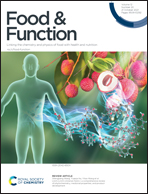Oxyresveratrol inhibits human colon cancer cell migration through regulating epithelial–mesenchymal transition and microRNA†
Abstract
The major cause of death in colorectal cancer (CRC) patients is metastasis. Moreover, lots of studies have emphasized that the epithelial–mesenchymal transition (EMT) is a pivotal step in metastasis. Both transforming growth factor beta (TGF-β) and dysregulation of microRNAs (miRNAs) can induce or regulate EMT, promoting the loss of intercellular adhesion and increased motility of cancer cells. Therefore, it is necessary to prevent or inhibit the metastasis of colorectal cancer. Relatively little is known about the anti-metastatic effect of oxyresveratrol (OXY), a natural derivative of resveratrol (RES), compared to RES. Accordingly, RES was used as the positive control to investigate the effects of OXY on colon cancer cell migration. The results showed that OXY could significantly inhibit cell migration (67.17% ± 0.04, 64.89% ± 0.04) compared to RES (84.6% ± 0.07, 76.34% ± 0.08) in HCT116 cells and TGF-β-induced HT-29 cells, respectively, via Snail/E-cadherin expression. In addition, OXY improved EMT-related miRNA expression through, for example, lowering the levels of miR-3687 and miR-301a-3p while upregulating miR-3612 in TGF-β-induced HT-29 cells. In conclusion, OXY inhibits human colon cancer cell migration by regulating EMT and miRNAs. Based on these findings, it can be stated that OXY promotes anti-metastatic properties in CRC.



 Please wait while we load your content...
Please wait while we load your content...